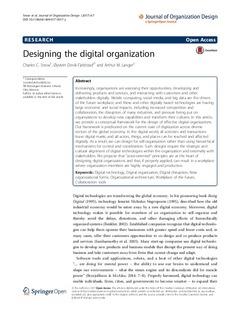Designing the digital organization
Journal article, Peer reviewed
Published version
Permanent lenke
http://hdl.handle.net/11250/2485277Utgivelsesdato
2017Metadata
Vis full innførselSamlinger
- Publikasjoner fra CRIStin - BI [1015]
- Scientific articles [2181]
Originalversjon
Journal of Organization Design, 2017, 6(7), 1-13 https://doi.org/10.1186/s41469-017-0017-ySammendrag
Increasingly, organizations are assessing their opportunities, developing and delivering products and services, and interacting with customers and other stakeholders digitally. Mobile computing, social media, and big data are the drivers of the future workplace, and these and other digitally based technologies are having large economic and social impacts, including increased competition and collaboration, the disruption of many industries, and pressure being put on organizations to develop new capabilities and transform their cultures. In this article, we provide a conceptual framework for the design of effective digital organizations. Our framework is predicated on the current state of digitization across diverse sectors of the global economy. In the digital world, all activities and transactions leave digital marks, and all actors, things, and places can be reached and affected digitally. As a result, we can design for self-organization rather than using hierarchical mechanisms for control and coordination. Such designs require the strategic and cultural alignment of digital technologies within the organization and externally with stakeholders. We propose that “actor-oriented” principles are at the heart of designing digital organizations and that, if properly applied, can result in a workplace where organization members are highly engaged and productive.
Beskrivelse
This is an Open Access journal available from Springer Open https://jorgdesign.springeropen.com/
